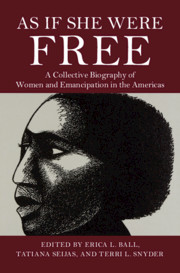Book contents
- As If She Were Free
- As If She Were Free
- Copyright page
- Dedication
- Contents
- Figures
- Contributors
- Elizabeth Catlett and the Form of Emancipation
- Acknowledgments
- Introduction
- Part I Claiming Emancipation during the Rise of New World Slavery
- Part II Experiencing Freedom during Slavery’s Expansion
- Part III Envisaging Emancipation during Second Slavery
- 14 Bessy Chambers, Nineteenth-Century Jamaica
- 15 Minerva, Nineteenth-Century Téjas and Louisiana (US), and Mexico
- 16 Cécile Fatiman and Petra Carabalí, Late Eighteenth-Century Haiti and Mid-Nineteenth-Century Cuba
- 17 Mary Ellen Pleasant, Nineteenth-Century Massachusetts and California (US)
- 18 Gabriela, Nineteenth-Century Rio Grande do Sul (Brazil)
- 19 Maria Firmina dos Reis, Nineteenth-Century Maranhão (Brazil)
- Part IV Enacting Emancipation in the Aftermath of Slavery
- Bibliography
- Index
14 - Bessy Chambers, Nineteenth-Century Jamaica
from Part III - Envisaging Emancipation during Second Slavery
Published online by Cambridge University Press: 24 September 2020
- As If She Were Free
- As If She Were Free
- Copyright page
- Dedication
- Contents
- Figures
- Contributors
- Elizabeth Catlett and the Form of Emancipation
- Acknowledgments
- Introduction
- Part I Claiming Emancipation during the Rise of New World Slavery
- Part II Experiencing Freedom during Slavery’s Expansion
- Part III Envisaging Emancipation during Second Slavery
- 14 Bessy Chambers, Nineteenth-Century Jamaica
- 15 Minerva, Nineteenth-Century Téjas and Louisiana (US), and Mexico
- 16 Cécile Fatiman and Petra Carabalí, Late Eighteenth-Century Haiti and Mid-Nineteenth-Century Cuba
- 17 Mary Ellen Pleasant, Nineteenth-Century Massachusetts and California (US)
- 18 Gabriela, Nineteenth-Century Rio Grande do Sul (Brazil)
- 19 Maria Firmina dos Reis, Nineteenth-Century Maranhão (Brazil)
- Part IV Enacting Emancipation in the Aftermath of Slavery
- Bibliography
- Index
Summary
In 1823, Bessy Chambers filed a complaint in the St. George’s slave court in Jamaica. Chambers, along with twenty-four unnamed enslaved people from the New Layton estate, charged that the overseer had forced her to work despite her pregnancy, causing her to miscarry. While her story contests notions of a benign system of slavery in its twilight years, the multidimensionality of Chambers’ gendered freedom claims also disputed the limiting vision of abolition reform for the enslaved, and for women in particular. Chambers and other enslaved women who had a long history of engaging in distinctly gendered struggles against slavery refused to accept the new subordinate roles abolitionist envisioned for them, although they could not always escape its oppressive reach. In going to court, Chambers revealed a right to self-determination as essential to her conceptualization of womanhood. Her pursuit of legal personhood must therefore be viewed as a dual fight against slavery and the restricted freedom abolitionists proposed.
- Type
- Chapter
- Information
- As If She Were FreeA Collective Biography of Women and Emancipation in the Americas, pp. 255 - 273Publisher: Cambridge University PressPrint publication year: 2020

